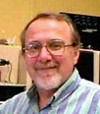Dale Chatfield
Professor Emeritus and Former Chair, Analytical Chemistry
office:
email: dchatfield@sdsu.edu

Curriculum Vitae
- Ph. D., University of North Carolina
- M.S., Oakland University, Michigan
- B.S., Oakland University, Michigan
Research Interests
I am an analytical chemist with 44 years working in academia and in industry. I have been measuring chemicals from air, and human breath for 20 years, in which time we have trained almost 200 graduate and undergraduate students in the science and art of chemical analysis, with many currently holding prominent positions in government laboratories and industry. In our laboratory at San Diego State University, we identify and quantify organic compounds as stable molecules or as metabolites using mass spectrometry and chromatographic methods. For the past 10 years, we have focused on the development of validated chemical procedures for analysis of small molecules, including bile acids and metabolites, antibiotic formulations, sphingosine and sphingosine 1-phosphate, other sphingolipids, testosterone and epitestosterone, cotinine, trans-3. hydroxy-cotinine, nicotine, 3-vinylpyridine, creatinine and others in numerous sample matrices including air, ambient dust, urine, soils, water, saliva, serum, whole and parotid saliva and other biological media.
Presently we have three areas of research. The first responds to a need from the environmental health community for a sensitive and inexpensive method to measure nicotine in air, dust and wipe samples. There are numerous NIH funded research programs that we support with analytical services. Our funding has primarily been from NIH and several state and federal Tobacco Research Funds to measure nicotine and nicotine metabolites in smoking related studies. To support vapor phase nicotine monitoring in confined spaces (homes, hotels and autos) we have designed an inexpensive passive dosimeter which is currently being field tested in three NIH funded studies in San Diego and Tel Aviv, Israel. To reduce testing costs for PI.s, we are developing a paper spray MS/MS technique for nicotine which can reduce the cost of analysis by half. As we are asked to provide several thousand of such analyses by different research groups, this could mean a considerable cost savings for funded tobacco research.
A second research area is to identify possible chemical markers of clandestine gravesites from using sensitive GC-MS methods. Over the past year we have been working with the San Diego Police and a unique dog named Buster who has been trained to differentiate between gravesites containing skeletonized remains from human from those of deer, dog, horse, etc. Several classes of compounds have been identified as probable markers of human gravesites, and we are developing more specific assays for two compound classes: aliphatic polyamines and aldehydes. In addition, for the past two years we have been developing a forensic technique to use human breath analysis for providing trace compound evidence.
A third project is to develop sensitive analytical methods to measure polyamines in autophagosomes from drosophila and heart cells in mice, work being done in conjunction with the SDSU Bioscience Center. In one goal in this work we have developed a quantitative LC-MS/MS method to analyze for the 9 most important polyamines in small amounts of intercellular matter. In the second part of this project is to develop analytical methods to separate 1-2 um dia. organelles from lysed whole cells. Conventional cell sorters (FACS) are not capable of doing this as the organelles are too small in diameter. We are using field flow fraction (FFF) techniques to accomplish this. We have succeeded in constructing our own gravitational-FFF unit and are in the process of calibrating it. FFF has the advantage of separating larger samples than can be conveniently achieved by FACS, but does not have as good resolving power. We will be comparing our component separation to that from a FACS. analyzing parts of this project.
Selected Publications
- Schmitz KE, Hovell MF, Wong CA, et al., The Reliability and Practicality of the Arkansas Method Assay of Isoniazid Adherence Clinical Nursing Research 2010, 19 131-143.
- Hofmann AF, Loening-Baucke V, Lavine JE, et al., Altered Bile Acid Metabolism in Childhood Functional Constipation: Inactivation of Secretory Bile Acids by Sulfation in a Subset of Patients Journal of Pediatric Gastroenterology and Nutrition 2008, 47 598-606.
- Matt GE, Quintana PJE, Hovell MF, et al., Residual tobacco smoke pollution in used cars for sale: Air, dust, and surfaces Nicotine and Tobacco Research 2008, 10 1467-1475.
- Wang L, Liu XD, Chatfield D, et al., Simultaneous determinations of nicotine and metabolites by LC-MS using an acclaim mixed-mode HILIC-1 column LC GC North America 2008, Feb 56-57.
- Hamilton JP, Xie GF, Raufman JP, et al., Human cecal bile acids: concentration and spectrum American Journal of Physiology-Gastrointestinal and Liver Physiology 2007, 293 G256-G263.
